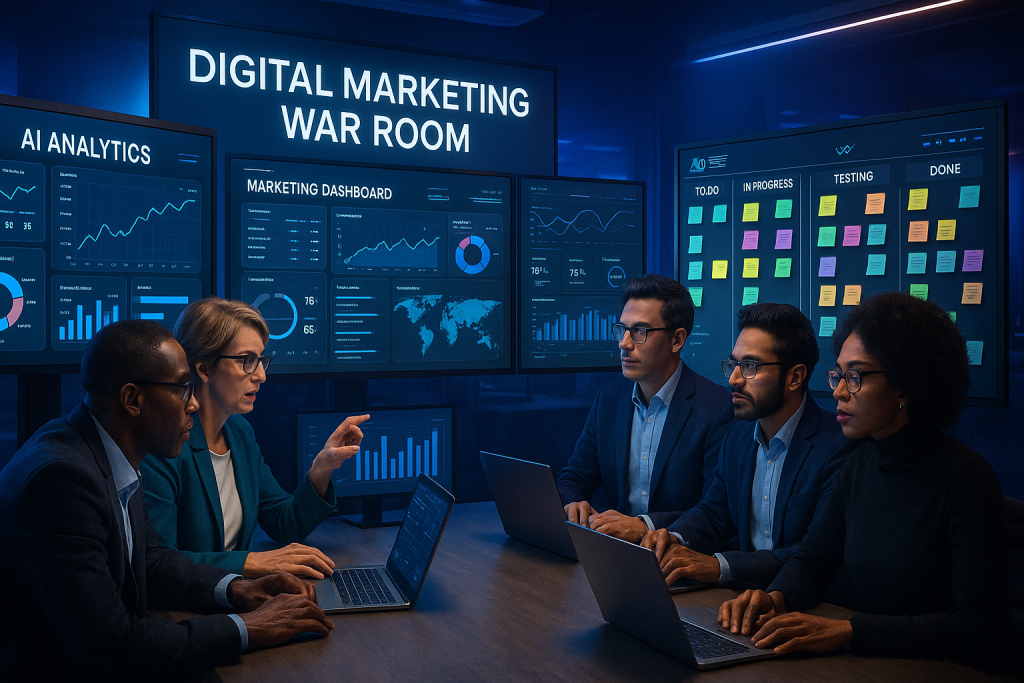As the digital landscape evolves at warp speed, marketing leaders face a growing challenge—how to build a Future-Proof Digital Playbook that withstands ongoing disruption. In 2025, customers expect personalization, agility, and authenticity across every touchpoint. To stay competitive, CMOs must anticipate change, adopt forward-thinking tools, and realign their strategies continuously. According to a 2025 Gartner report, over 67% of marketing budgets are now allocated to digital channels. This shift is not just about technology; it’s about mindset. In this article, we’ve compiled exclusive insights from top Chief Marketing Officers (CMOs) across industries. These leaders share their most effective strategies for building a resilient, adaptable, and performance-driven Future-Proof Digital Playbook. Whether you’re a startup founder or a seasoned marketer, these battle-tested tips will help you prepare for what’s next—while thriving in the present.

1. Embrace an Agile Framework to Future-Proof Your Strategy
Agility is the cornerstone of any future-ready digital marketing strategy. Leading CMOs agree that rigid annual plans are no longer viable in a fast-moving ecosystem. Instead, marketers must adopt quarterly sprints, test-and-learn cycles, and real-time data analysis. This ensures faster reaction to market shifts and evolving consumer behavior. For instance, PepsiCo’s CMO reported a 38% boost in campaign ROI after switching to an agile content model in 2024. Agile methods enable small, rapid iterations, which are essential when experimenting with AI tools, new platforms, or shifting regulations. Additionally, teams aligned with agile workflows are more empowered, collaborative, and accountable. A future-proof digital playbook must integrate continuous feedback loops, allowing marketers to optimize on the fly. This approach helps brands avoid sunk costs, focus on ROI, and stay ahead of emerging digital trends like voice commerce or augmented reality.
Key Agile Implementation Tips
- Use Kanban boards to visualize progress
- Run weekly sprint reviews
- Automate low-value tasks to free up creative time
- Collect consumer data weekly
- Align content with real-time trends
2. Invest in First-Party Data for Smarter Personalization
In a cookieless future, first-party data is the new oil. Google plans to phase out third-party cookies entirely by late 2025, making it urgent for marketers to pivot. CMOs at major brands are doubling down on first-party data strategies through loyalty programs, surveys, and gated content. According to McKinsey’s 2025 marketing report, campaigns powered by first-party data outperform others by 28% in conversion rates. Consumers also respond better when personalization is based on data they’ve willingly shared. The key is transparency—make it clear how their data will be used, and offer real value in return. For example, Sephora uses app behavior and purchase history to tailor exclusive offers, leading to a 34% increase in app engagement. To future-proof your digital playbook, start building a privacy-first data ecosystem today.
First-Party Data Tools to Adopt
- CDPs like Segment or BlueConic
- Interactive quizzes for data capture
- Email opt-ins with exclusive content
- Loyalty dashboards with user history
- Customer surveys and polls
3. Focus on Content Velocity Without Sacrificing Quality
Quality content at scale is the backbone of modern marketing. However, content velocity—how fast you produce high-performing assets—can define success in 2025. CMOs are shifting toward decentralized content creation models by leveraging in-house teams, freelancers, and AI-assisted tools. Brands like Airbnb use AI tools for A/B content testing, ensuring every blog post or video delivers results. But velocity doesn’t mean volume without purpose. Leading marketers insist on a content governance strategy that ensures consistency, brand tone, and compliance. By standardizing content templates and leveraging analytics, brands can publish faster while keeping quality high. Think of it as a production line built on creativity, speed, and data. This dual focus on quality and agility sets the stage for real-time engagement, viral content, and deeper user trust.
Ways to Accelerate Content Without Sacrificing Impact
- Use an editorial calendar aligned with quarterly goals
- Repurpose long-form blogs into reels, tweets, and carousels
- Standardize your visual identity with AI design tools
- Create modular content blocks for rapid deployment
- Analyze engagement weekly to guide future content
4. Use AI for Smart Automation, Not Creative Replacement
AI is not here to replace marketers—it’s here to enhance your superpowers. That’s the mantra from CMOs leading innovation in 2025. Generative AI tools like ChatGPT, Jasper, and Midjourney are helping marketers streamline everything from customer segmentation to ad copy. However, the real edge lies in human-AI collaboration. For example, IBM’s marketing team uses AI to generate email subject lines, which human editors fine-tune for tone and brand. This balance ensures faster output without losing the human touch. CMOs also stress the importance of ethical AI use, especially with deepfake risks and misinformation concerns rising. Your digital playbook should include clear AI guidelines, ethical standards, and training for creative teams. Smart automation can unlock more time for innovation, relationship-building, and strategy refinement.
Smart Ways to Use AI Without Losing Your Brand Voice
- AI-generated drafts, human-edited for voice
- Predictive analytics for campaign timing
- Chatbots for 24/7 support, reviewed monthly
- Visual asset creation with brand consistency
- Dynamic personalization on landing pages
5. Align Marketing KPIs with Business Outcomes
Top CMOs agree: marketing KPIs must evolve. In 2025, metrics like “likes” or “followers” carry less weight. Instead, focus shifts to customer lifetime value (CLV), lead-to-close rate, and brand equity. Your digital playbook must tightly align marketing goals with overall business objectives. A CMO at a fintech firm shared how they replaced vanity metrics with KPIs like Net Revenue Retention (NRR), resulting in clearer ROI. Integrated dashboards that pull data from sales, marketing, and CX systems provide a full-funnel view of what’s working. CMOs recommend revisiting KPIs quarterly, especially when launching new channels or targeting new audiences. Strong alignment enables cross-functional collaboration, from product to sales to support—turning marketing from a cost center into a revenue engine.
Metrics That Matter in a Future-Proof Digital Playbook
- Customer acquisition cost (CAC)
- Marketing-sourced revenue
- Engagement depth (scroll depth, session time)
- Net Promoter Score (NPS)
- Organic share of voice (SOV)
FAQs: Building a Future-Proof Digital Playbook
1. What is a digital playbook in marketing?
A digital playbook is a documented strategy that outlines your brand’s approach to digital marketing, tools, channels, and KPIs.
2. Why is agility important in digital marketing today?
Agility helps brands respond to market shifts faster, test new tactics, and optimize campaigns for better results.
3. How do I collect first-party data ethically?
Be transparent, offer value (like exclusive content), and always allow users to opt in or out easily.
4. What role does AI play in content creation for 2025?
AI assists with speed and data insights but should be paired with human creativity to preserve brand authenticity.
5. How can CMOs future-proof their marketing teams?
By embracing tech, continuous learning, agile methods, and aligning KPIs with real business outcomes.

